Influence of Guardrails on Track–Bridge Interaction with a Longitudinal Resistance Test of the Fastener
Abstract
:Featured Application
Abstract
1. Introduction
2. Longitudinal Resistance Test of the Guardrail Fastener
2.1. Test Process
2.2. Test Results
3. Materials and Methods
3.1. Model Establishment and Verification
3.2. Parameters of Bridges
3.3. Parameters of the Track
3.4. Parameters of the Train Load
4. Effects of Guardrails
4.1. Expansion Conditions
4.2. Bending Conditions
4.3. Braking Conditions
4.4. Rail Breaking Conditions
5. Maximum Longitudinal Stiffness of Piers for CGBs
6. Conclusions
- (1)
- The Langmuir EXT1 function is employed as an effective mathematical model for the rising stage of the load–displacement curve that represents the LRGRF. The nominal longitudinal resistance and the elastic longitudinal displacement of the rail prior to slipping grow approximately linearly with the increase in the installation torque. As the installation torque varies from 40 N·m to 60 N·m, the nominal longitudinal resistance and longitudinal displacement of the rail prior to slipping change from 3.91 kN to 6.46 kN and from 0.15 mm to 0.29 mm, respectively.
- (2)
- The interaction between the stock rail and the guardrail could lessen the track–bridge interaction of the CWR on the bridge. Additionally, this results in a reduction of both the SRLF and the rail broke gap, with a stock rail braking force reduction of up to 28.0%.
- (3)
- The existence of a breathing zone of the guardrail can exacerbate the track–bridge interaction of the CWR near the abutment with moveable bearings. In a special case, when the spans of the CGB and the longitudinal stiffness of piers for simply supported bridges are small, the SRLF at the abutment position is even greater than the force at the CGB end position. This enables the abutment position to become a new control point for the design of CWR on bridges.
- (4)
- If the installation torque of the guardrail fastener is too high, the SRLF under expansion conditions greatly increases. Conversely, if the torque is too small, the stock rail braking force noticeably grows. Hence, in general, an installation torque of 40–60 N·m is recommended. If the JRGR is too large, the SRLF under expansion conditions also increases significantly. If the JRGR is too small, the variation of the guardrail gap is large. Therefore, the JRGR is generally recommended to be in the interval of 370–430 kN.
- (5)
- If the temperature span of the CGB is lower than 124 m, the influence of guardrails must be considered in the design of the CWR on bridges. When the longitudinal stiffness of the pier for the CGB is less than the recommended maximum value proposed in the paper, the existing simplified model without guardrails can be effectively employed in the design of the CWR.
Author Contributions
Funding
Institutional Review Board Statement
Informed Consent Statement
Data Availability Statement
Conflicts of Interest
References
- Liu, X.; Saat, M.R.; Barkan, C.P.L. Analysis of Causes of Major Train Derailment and Their Effect on Accident Rates. Transp. Res. Rec. 2012, 2289, 154–163. [Google Scholar] [CrossRef]
- Gong, K.; Liu, L.Y.; Xiang, J.; Yu, C.Y.; Liu, Q.M.; Yang, H.M. Effects of Crosswind on Freight Train Derailment Process on Heavy Haul Railway Bridge. J. China Railw. Soc. 2022, 44, 125–134. [Google Scholar]
- Braghin, F.; Bruni, S.; Diana, G. Experimental and Numerical Investigation on the Derailment of a Railway Wheelset with Solid Axle. Veh. Syst. Dyn. 2006, 44, 305–325. [Google Scholar] [CrossRef]
- Koo, J.S.; Oh, H.S. A New Derailment Coefficient considering Dynamic and Geometrical Effects of a Single Wheelset. J. Mech. Sci. Technol. 2014, 28, 3483–3498. [Google Scholar] [CrossRef]
- Wu, X.W.; Chi, M.R.; Gao, H. the Study of Post-Derailment Dynamic Behavior of Railway Vehicle based on Running Tests. Eng. Fail. Anal. 2014, 44, 382–399. [Google Scholar] [CrossRef]
- Diana, G.; Sabbioni, E.; Somaschini, C.; Tarsitano, D.; Cavicchi, P.; Mario, M.D.; Labbadia, L. Full-Scale Derailment Tests on Freight Wagons. Veh. Syst. Dyn. 2021, 60, 1849–1866. [Google Scholar] [CrossRef]
- Zhang, T.; Guo, X.R.; Jin, T.M.; Yang, Y.F.; Ling, L.; Wang, K.Y.; Zhai, W.M. Dynamic Derailment Behaviour of Urban Tram subjected to Lateral Collision. Int. J. Rail Transp. 2022, 10, 581–605. [Google Scholar] [CrossRef]
- Shu, X.; Wilson, N. Guidelines for Guard/Restraining Rail Installation; Transit Cooperate Research Program Report 71; Transportation Research Board: Washington, DC, USA, 2010; Volume 7. [Google Scholar]
- Gook, J.S. A Study on the Crash Analysis of Guard Rail. J. Korean Soc. Manuf. Technol. Eng. 2011, 20, 598–604. [Google Scholar]
- Wang, J.; Shen, G. Analysis on Parameters of Inner-Side Guardrail against Derailment on High-Speed Railway. High Speed Railw. Technol. 2013, 4, 7–11. [Google Scholar]
- Nishimura, K.; Terumichi, Y.; Morimura, T.; Adachi, M.; Morishita, Y.; Miwa, M. Using Full Scale Experiments to Verify a Simulation used to Analyze the Safety of Rail Vehicles during Large Earthquakes. J. Comput. Nonlinear Dyn. 2015, 10, 031013. [Google Scholar] [CrossRef]
- Ling, L.; Dhanasekar, M.; Thambiratnam, D.P.; Sun, Y.Q. Minimising Lateral Impact Derailment Potential at Level Crossings through Guard Rails. Int. J. Mech. Sci. 2016, 113, 49–60. [Google Scholar] [CrossRef] [Green Version]
- Sun, Y.Q. Mitigating Train Derailments Due to Sharp Curve and Overspeed. Front. Mech. Eng. 2018, 4, 1–12. [Google Scholar] [CrossRef]
- Lai, J.; Xu, J.M.; Wang, P.; Chen, J.Y.; Chen, R. Numerical Investigation on the Dynamic Behaviour of Derailed Railway Vehicles Protected by Guard Rail. Veh. Syst. Dyn. 2020, 59, 1803–1824. [Google Scholar] [CrossRef]
- Qiu, C.; Yang, G.; Xie, K.Z. Research of Reserved Joint Gap of 50 m Rail on Simply Supported Beam Bridges for Access Railroad. J. Shijiazhuang Tiedao Univ. 2020, 33, 97–102. [Google Scholar]
- Wei, X.K.; Chen, R.; Wang, P. Guard Rail’s Influence on the Stability of Continuously Welded Rail on Bride. China Railw. Sci. 2012, 33, 8–12. [Google Scholar]
- Fryba, L. Quasi-Static Distribution of Braking and Starting Forces in Rail and Bridges. Rail Int. 1974, 4, 7–18. [Google Scholar]
- Yan, B.; Kuang, W.F.; Gan, R.; Xie, H.R.; Huang, J. Track–Bridge Interaction of CWR on Chinese Large-Span Bridge of High-Speed Railway. Appl. Sci. 2022, 12, 9100. [Google Scholar] [CrossRef]
- Yang, H.Y.; Wu, N.H.; Zhang, W.; Liu, Z.J.; Fan, J.F.; Wang, C.J. Dynamic Response of Spatial Train-Track-Bridge Interaction System Due to Unsupported Track Using Virtual Work Principle. Appl. Sci. 2022, 12, 6156. [Google Scholar] [CrossRef]
- Han, Z.L.; Zhu, S.Y.; Zhai, W.M.; Zhu, B. Static and dynamic effects of train-track-bridge system subject to environment-induced deformation of long-span railway bridge. Proc. Inst. Mech. Eng. F J. Rail Rapid Transit. 2022, 237, 93–103. [Google Scholar] [CrossRef]
- Ruge, P.; Birk, C. Longitudinal Forces in Continuously Welded Rails on Bridgedecks Due to Nonlinear Track-Bridge Interaction. Comput. Struct. 2007, 85, 458–475. [Google Scholar] [CrossRef]
- Wang, P.; Xiao, J.L.; Chen, R.; Tian, C.X. Technology of Continuous Welded Rail on Bridges for High-Speed Railway; China Railway Publishing House: Beijing, China, 2016; pp. 10–109. [Google Scholar]
- Zhang, P.F.; Gui, H.; Lei, X.Y.; Gao, L. Deflection Force and Displacement of CRTS III Slab Track on Bridge under Train Load. J. Traffic Transp. Eng. 2018, 18, 61–72. [Google Scholar]
- Cho, S.; Lee, K.C.; Jang, S.Y.; Lee, I.; Chung, W. Sequential Track-Bridge Interaction Analysis of Quick-Hardening Track on Bridge Considering Interlayer Friction. Appl. Sci. 2020, 10, 5066. [Google Scholar] [CrossRef]
- Ruge, P.; Widarda, D.R.; Schmalzlin, G.; Bagayoko, L. Longitudinal Track-Bridge Interaction Due to Sudden Change of Coupling Interface. Comput. Struct. 2009, 87, 47–58. [Google Scholar] [CrossRef]
- Xie, K.Z.; Zhao, W.G.; Cai, X.P.; Wang, P.; Zhao, J. Interaction between Track and Long-Span Cable-Stayed Bridge: Recommendations for Calculation. Math. Probl. Eng. 2020, 2020, 5463415. [Google Scholar] [CrossRef]
- Xie, K.Z.; Chen, R.; Cui, Y.P.; Wang, X.M. Analysis of Bride-Rail Interaction on Sharply Curved Viaduct Accommodating Modern Tram. Bridg. Constr. 2021, 51, 81–87. [Google Scholar]
- Liu, W.S.; Lai, H.; Dai, G.L.; Rao, S.W.; Wang, D.Z.; Wu, B. Numerical Study on Track–Bridge Interaction of Integral Railway Rigid-Frame Bridge. Appl. Sci. 2021, 11, 922. [Google Scholar] [CrossRef]
- Czyczula, W.; Solkowski, J.; Towpik, K. Interaction between CWR Track and Bridges in Longitudinal Direction. Arch. Civ. Eng. 1997, 43, 51–69. [Google Scholar]
- Xu, Q.Y.; Chen, X.F.; Zhou, X.L.; Yang, X.L. Mechanics Computation Model Comparison of Continuously Welded Rails on High Speed Railway Bridges. J. Traffic Transp. Eng. 2005, 5, 19–24. [Google Scholar]
- Wenner, M.; Lippert, P.; Plica, S.; Marx, S. Track-bridge-interaction—Part 1: Historical development and model. Bautechnik 2016, 93, 59–67. [Google Scholar] [CrossRef]
- Arya, A.S.; Agrawal, S.R. Dispersion of Tractive and Braking Forces in Railway Bridge-Theoretical Analysis. Rail Int. 1982, 13, 12–25. [Google Scholar]
- Lu, Y.R.; Feng, S.Q. Calculation Method for the Discrete Force of CWR on Railway Bridge. Rail Int. 1987, 9, 56–67. [Google Scholar]
- Chen, X.F.; Zhu, W.Z.; Liu, X.J.; Tang, L. Application of Generalized Variational Principle to Calculation of Additional Expansion and Contraction Forces of CWR on Bridge. J. Railw. Sci. Eng. 2005, 2, 13–17. [Google Scholar]
- Okelo, R.; Olabimtan, A. Nonlinear Rail-Structure Interaction Analysis of an Elevated Skewed Steel Guideway. J Bridge Eng. 2011, 16, 392–399. [Google Scholar] [CrossRef]
- Yan, B.; Dai, G.L. Analysis of High Speed Railway Beam Rail Interaction Considering Loading History. J. China Railw. Soc. 2014, 36, 75–80. [Google Scholar]
- Zheng, J.; Wu, D.J.; Li, Q. Loading-History-Based Track-Bridge Interaction Analysis with Experimental Fastener Resistance. Eng. Struct. 2015, 83, 62–73. [Google Scholar] [CrossRef]
- Xie, K.Z.; Li, L.Y.; Liu, H.; Cai, X.P.; Wang, P. Bridge-track Interaction of Continuous Welded Rail on Bridge Based on the Longitudinal Resistance of Track Frame. J. Railw. Eng. Soc. 2019, 36, 38–43+59. [Google Scholar]
- Wenner, M.; Marx, S.; Koca, M. Additional Rail Stresses Due to Long-Term Deformations of Railway Viaducts with Ballastless Track-Model and Reality. Bautechnik 2019, 96, 674–695. [Google Scholar] [CrossRef]
- Yan, B.; Pan, W.B.; Meng, Y.Y.; Xu, Q.Y. Mechanical characteristics of Railway Continuous Rigid Frame Bridge Track System under shrinkage and creep. J. China Railw. Soc. 2017, 39, 99–103. [Google Scholar]
- EN13146-1:2002; Railway Applications-Track-Test Methods for Fastening System-Part 1: Determination of Longitudinal Rail Restraint. European Committee for Standardization: Brussels, Belgium, 2002.
- Saleem, A.; Tamura, H.; Katsuchi, H. Change in Surface Topography of Structural Steel Under Cyclic Plastic Deformation. In Proceedings of the 9th International Conference on Fracture, Fatigue and Wear, Ghent, Belgium, 2 August 2021. [Google Scholar]
- TB 10015-2012; Code for Design of Railway Continuous Welded Rail. China Railway Publishing House: Beijing, China, 2013.
- Ali, K.; Javed, A.; Mustafa, A.E.; Saleem, A. Blast-Loading Effects on Structural Redundancy of Long-Span Suspension Bridge Using a Simplified Approach. Pract. Period. Struct. Des. 2022, 27, 0000699. [Google Scholar] [CrossRef]
- TB T 3466-2016; Code for Train Load Diagrams. China Railway Publishing House: Beijing, China, 2016.
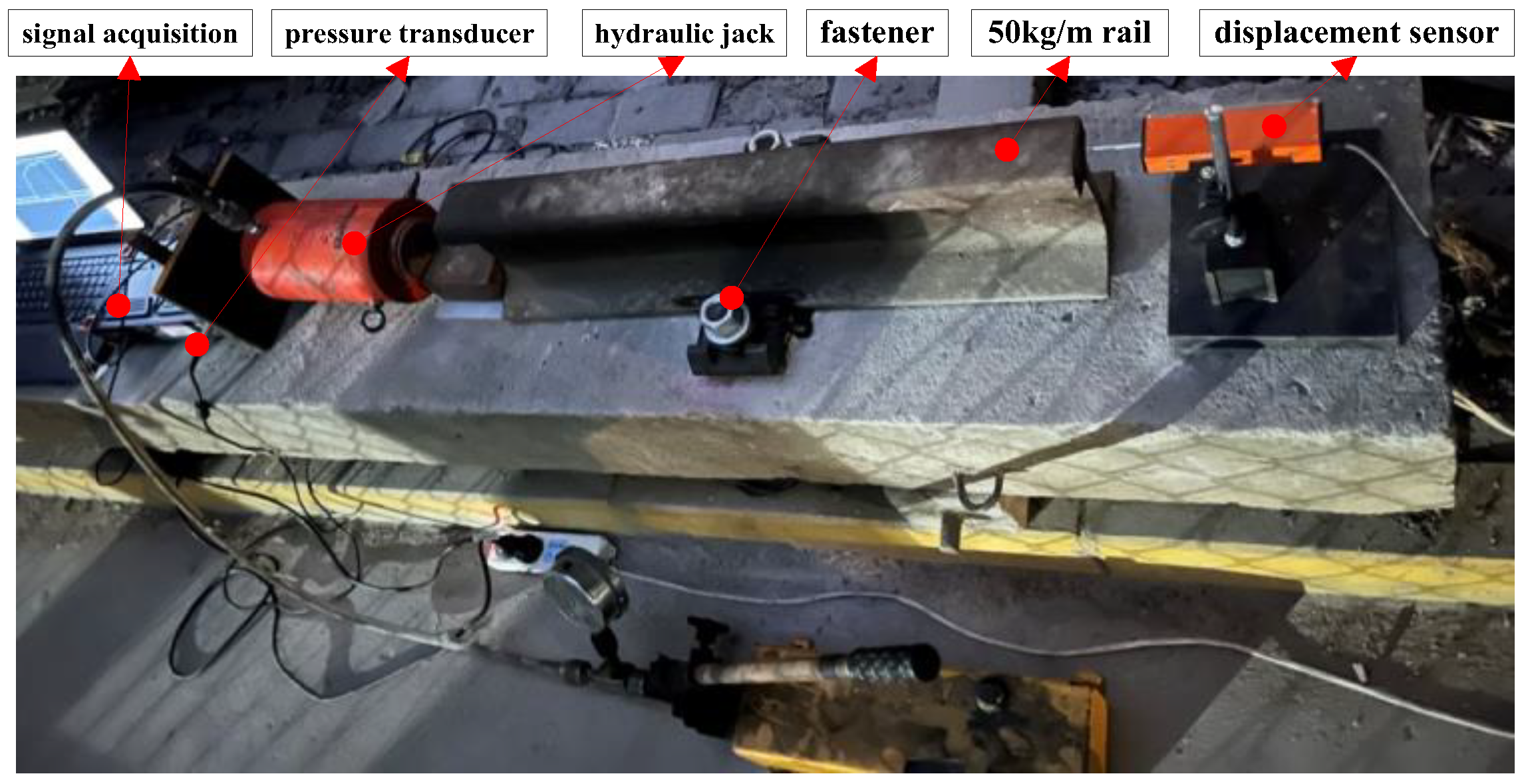
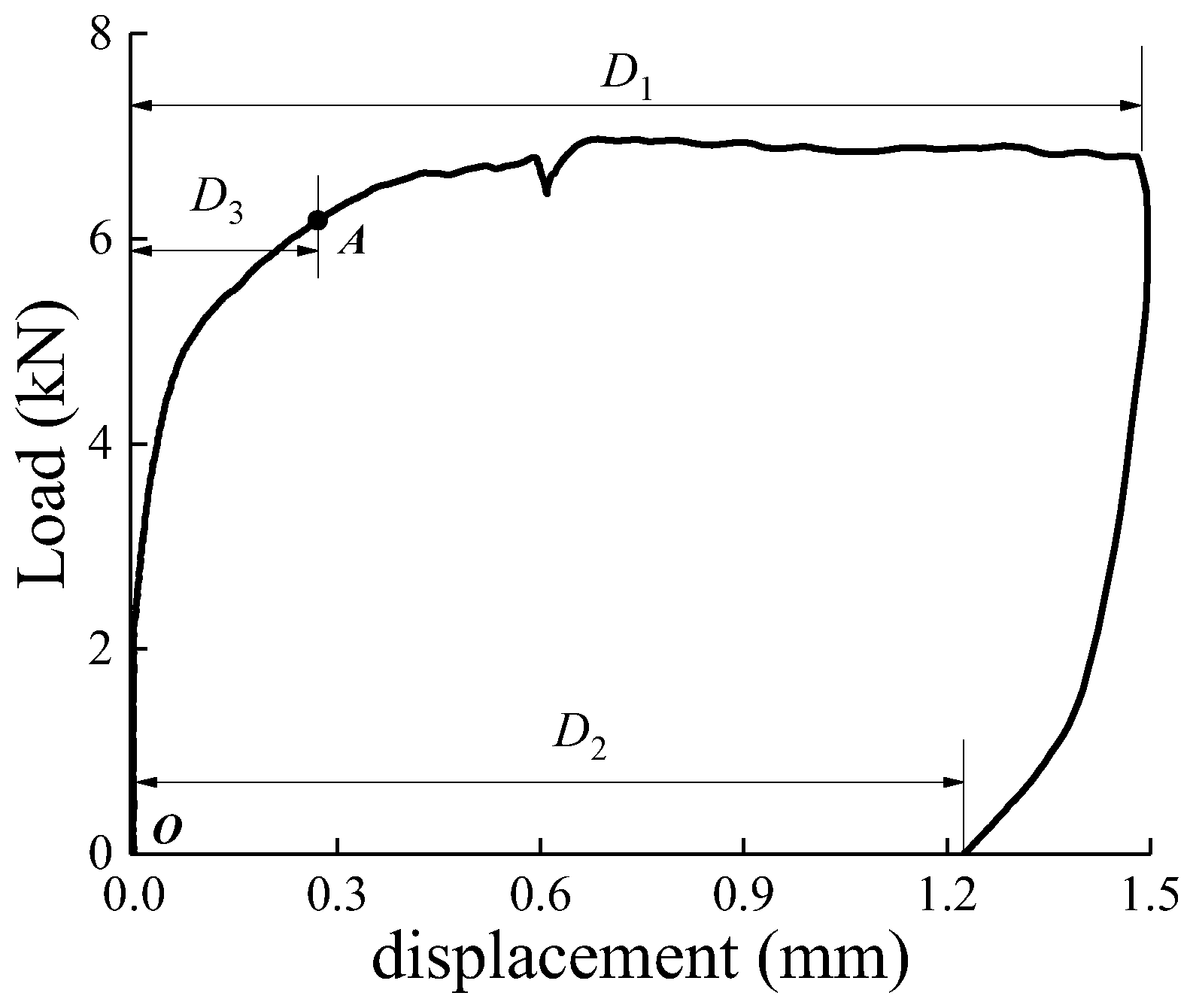

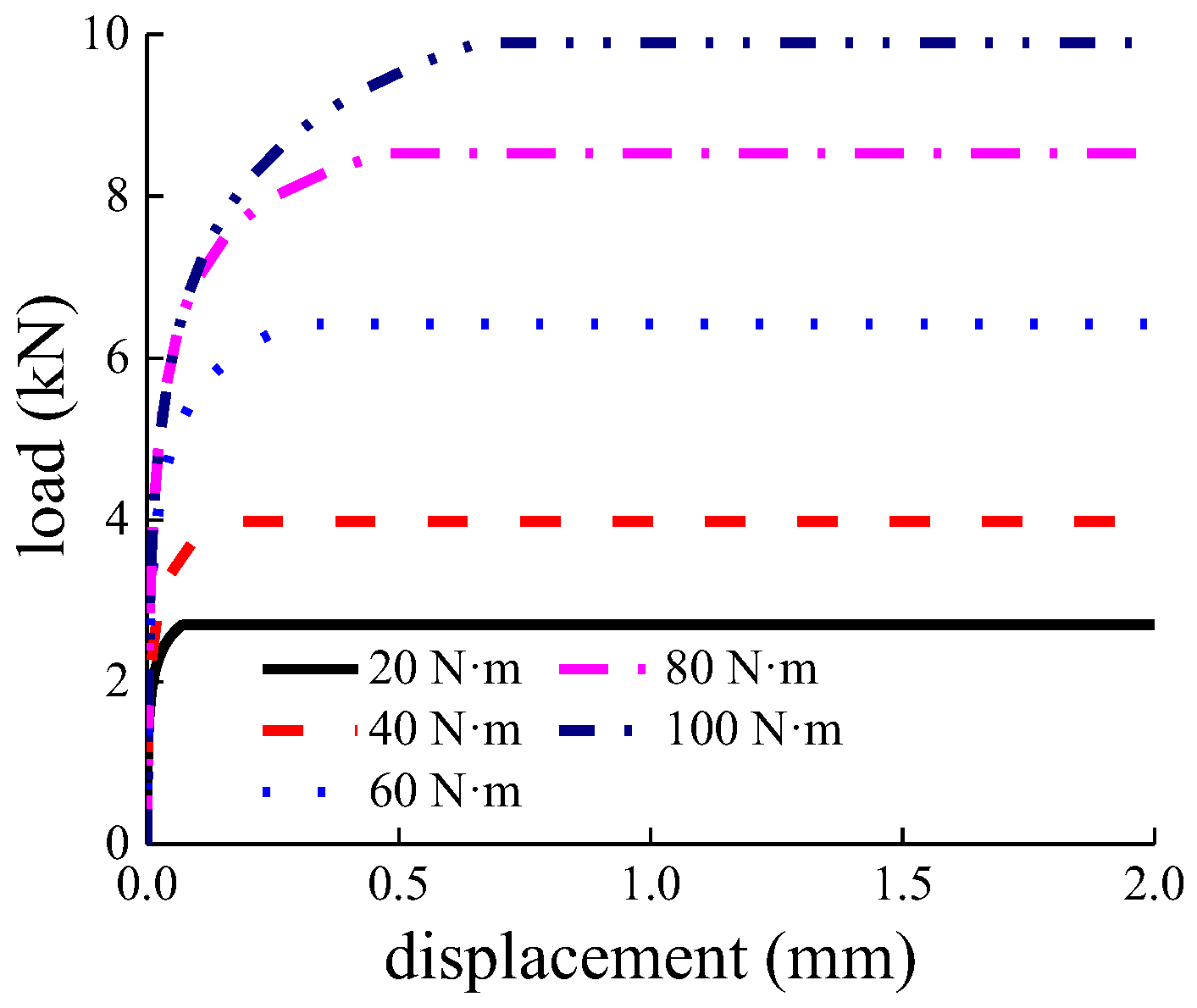
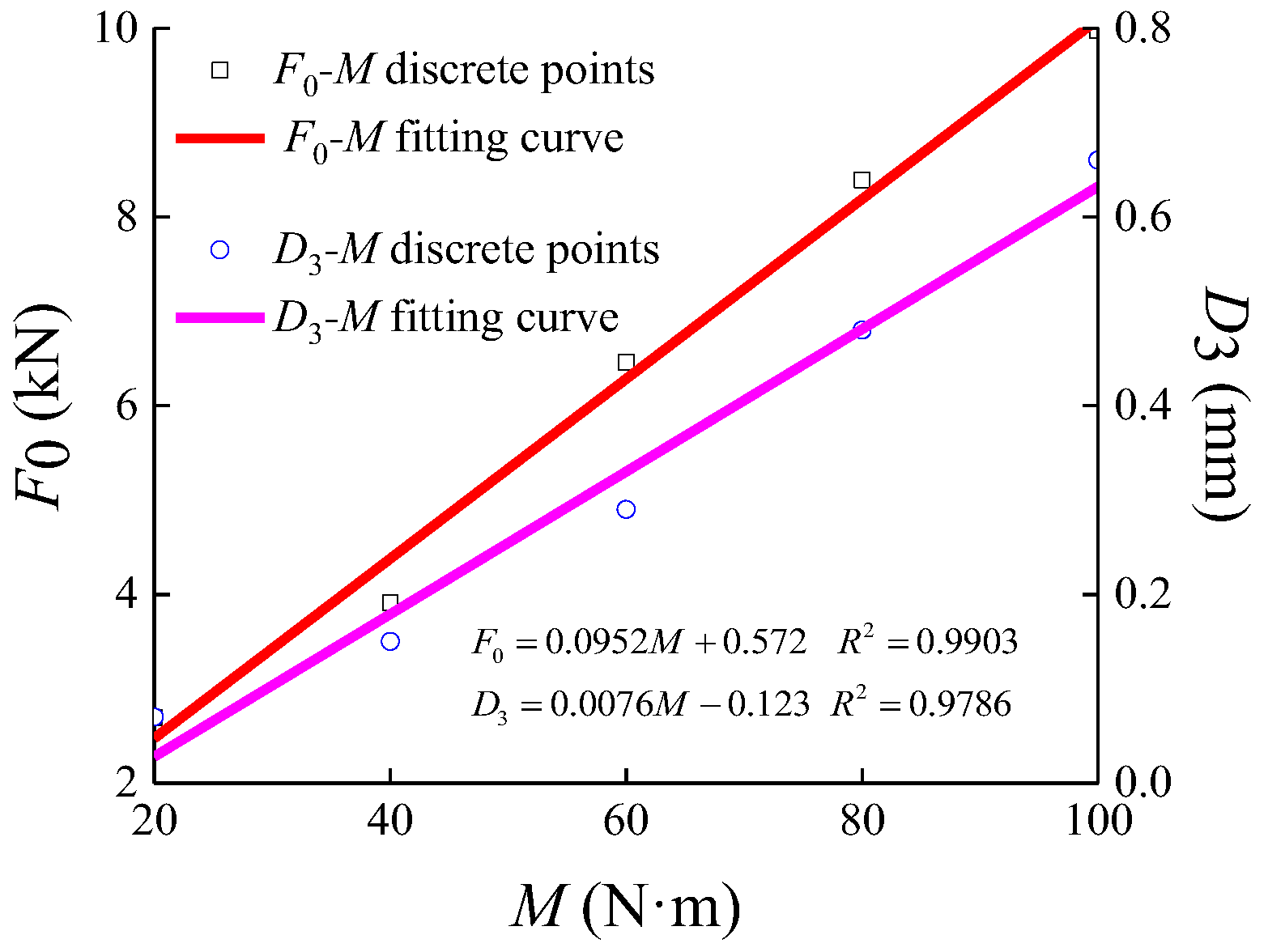

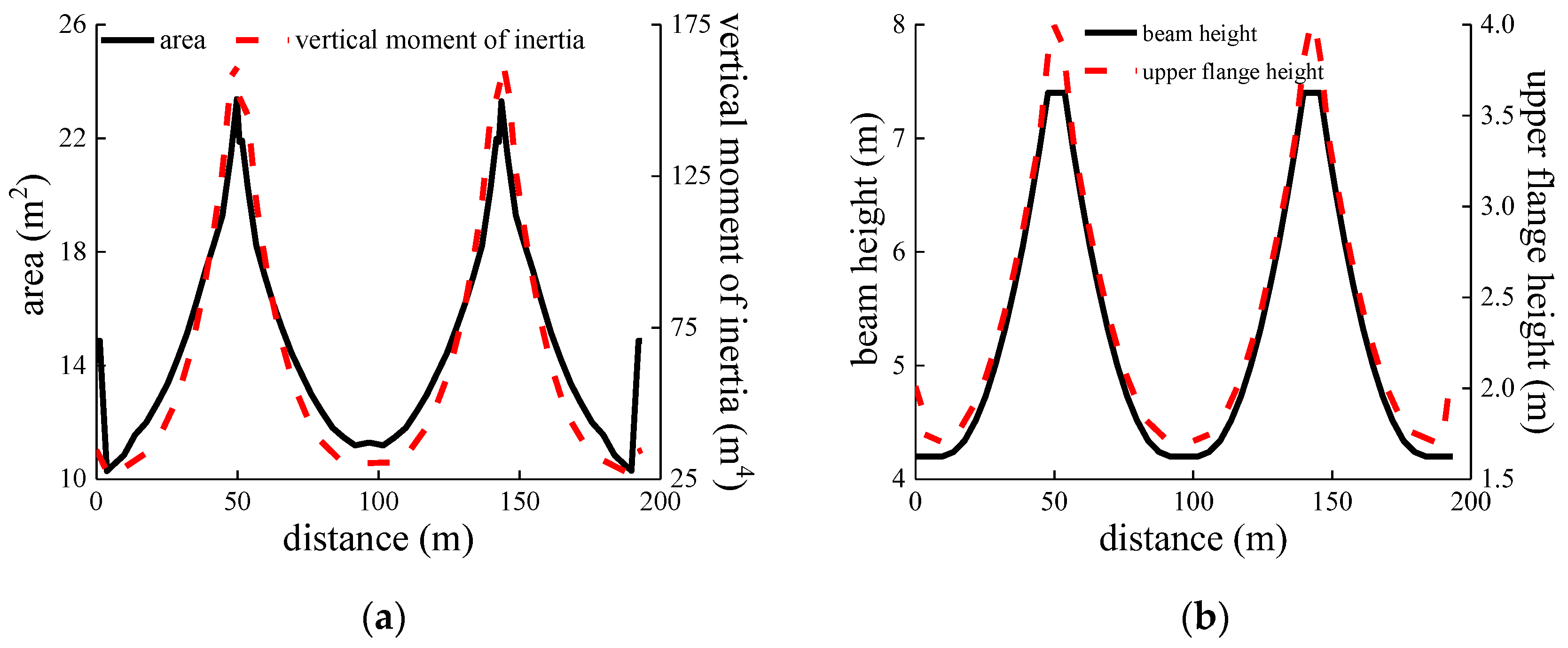



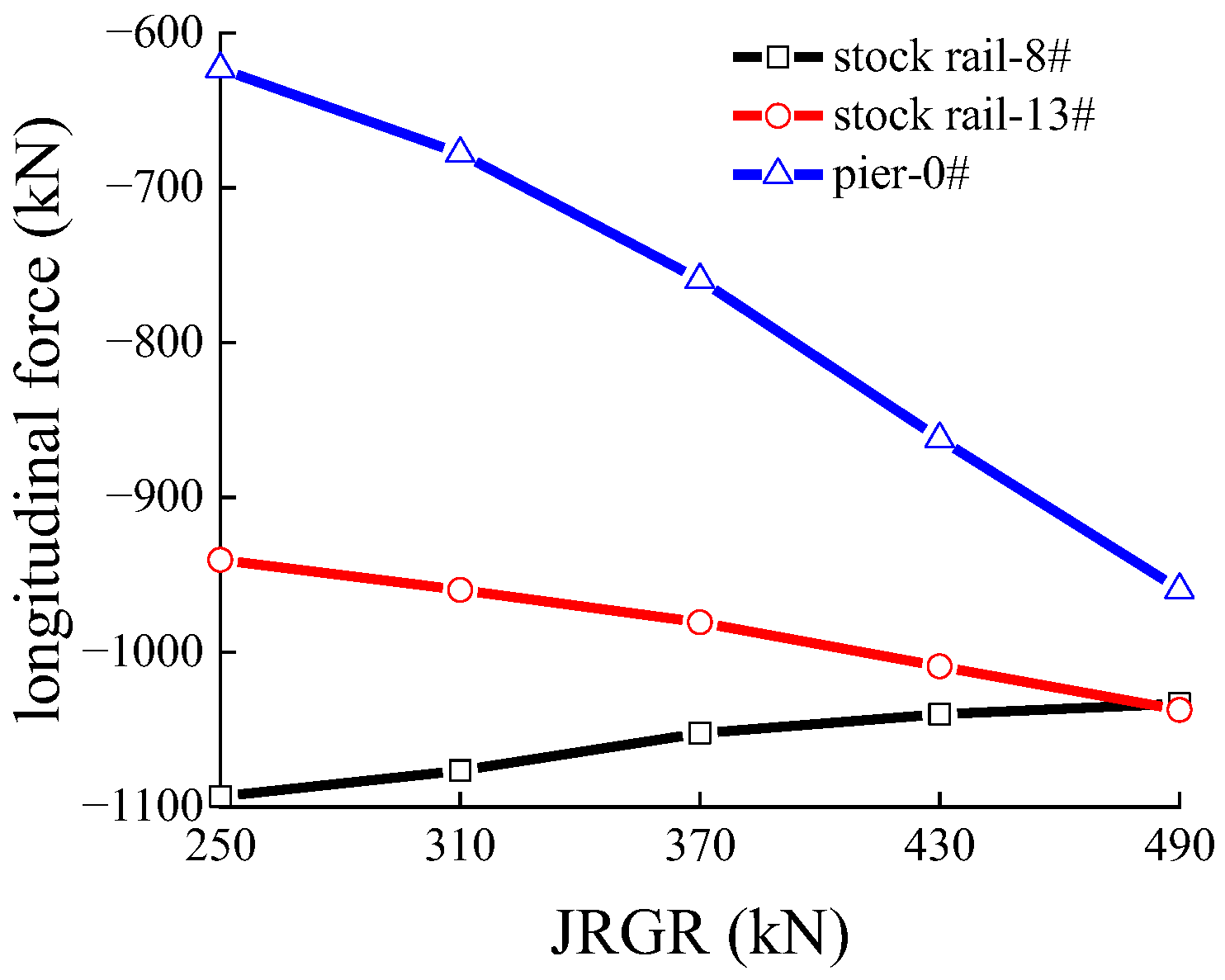
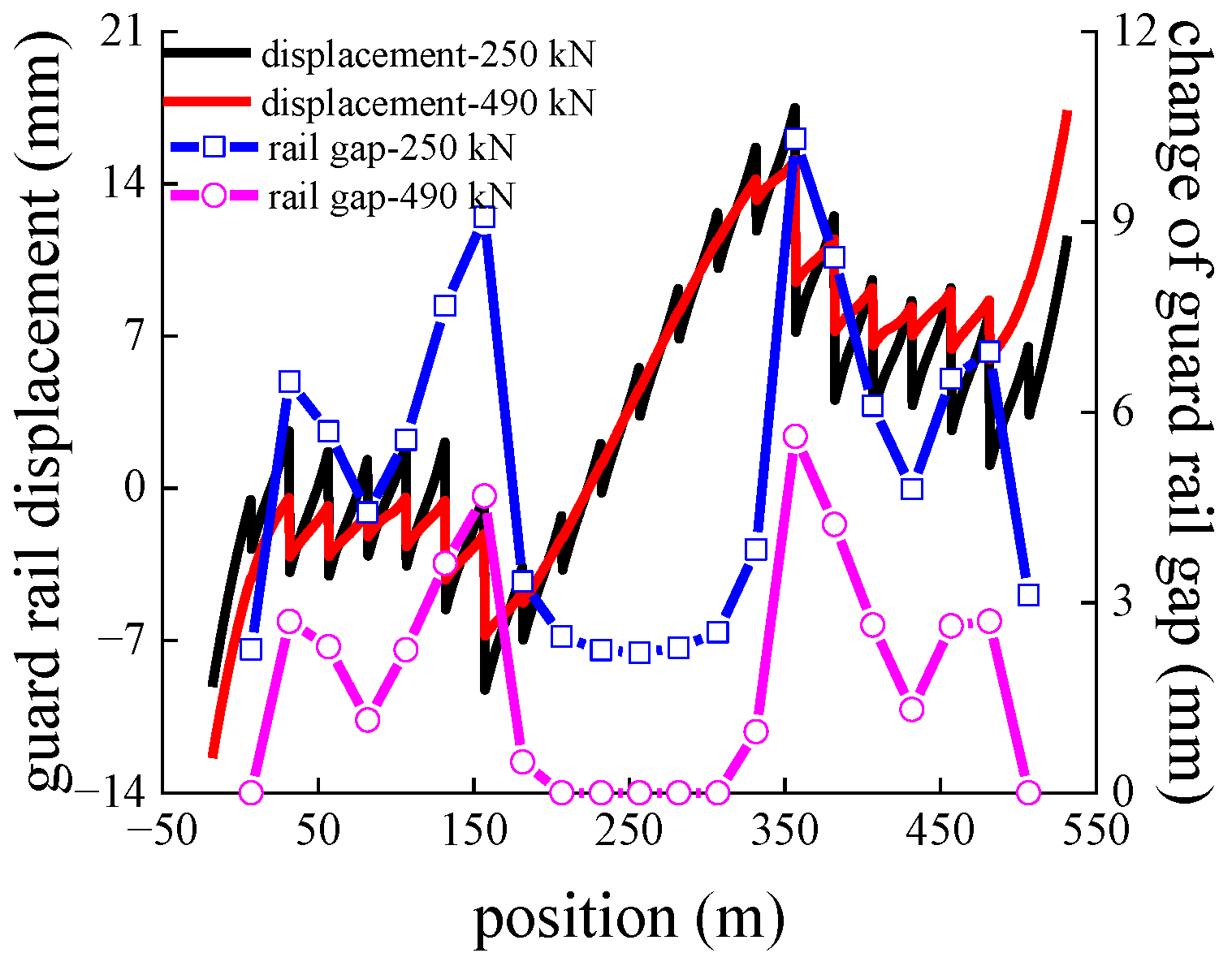
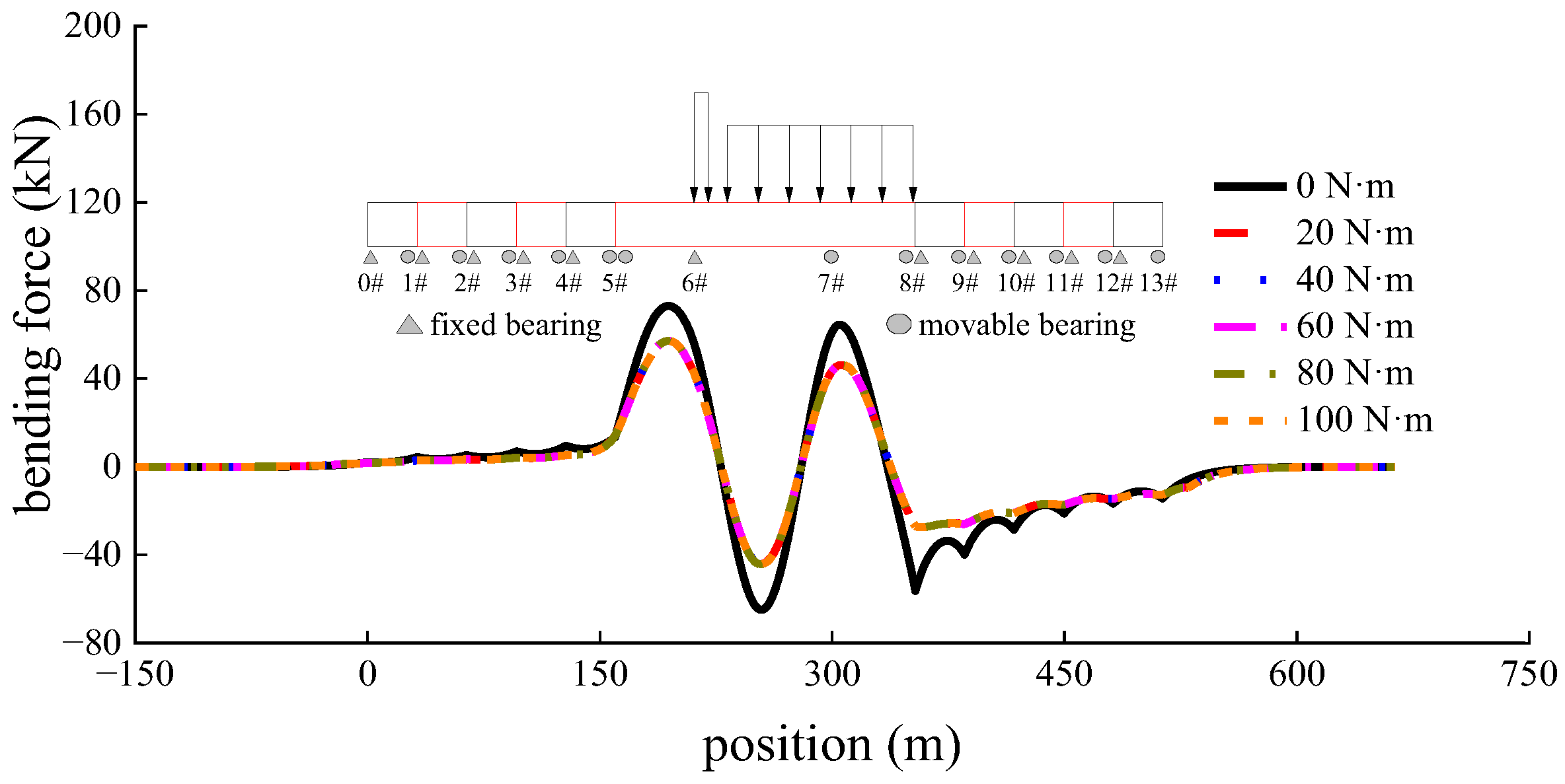
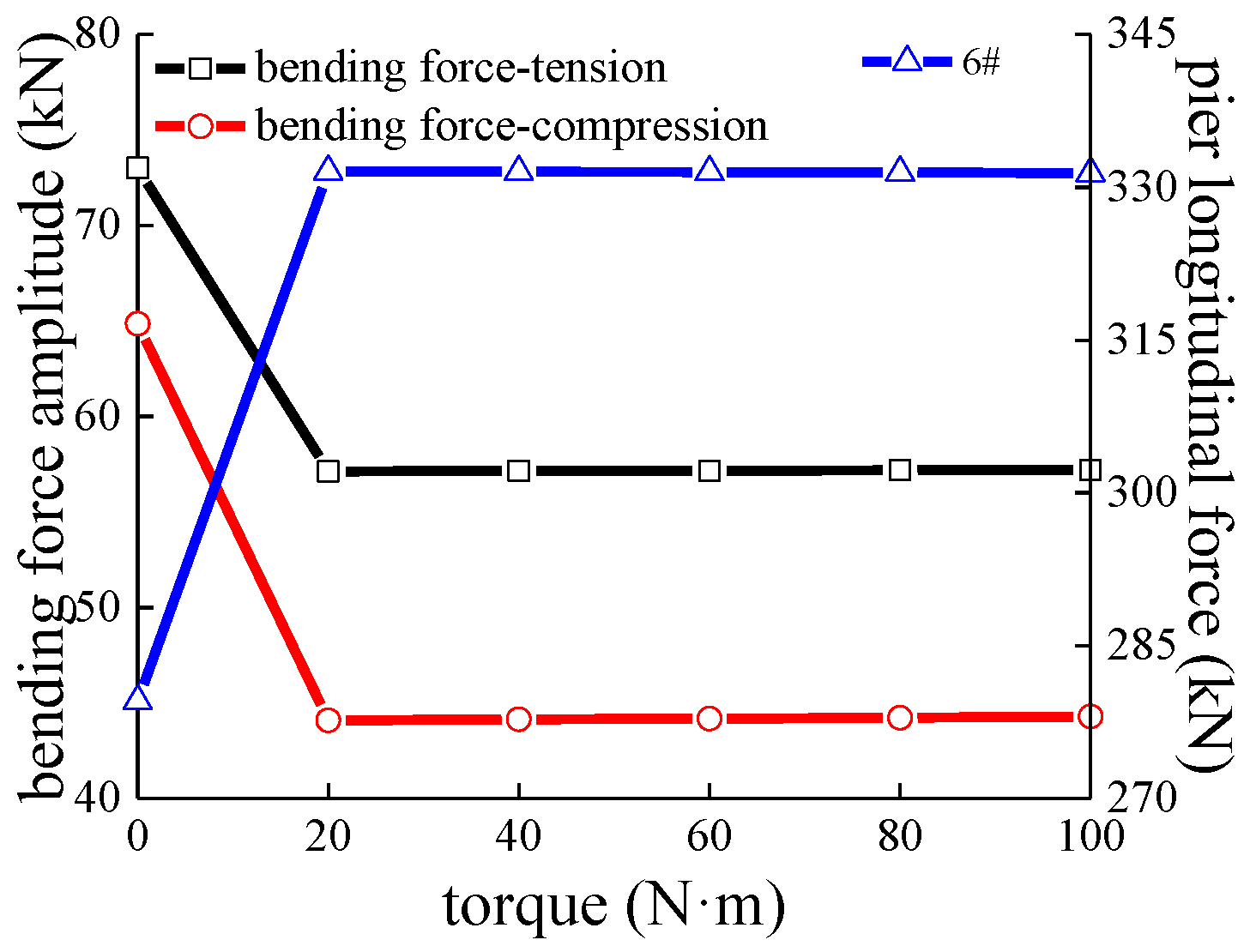
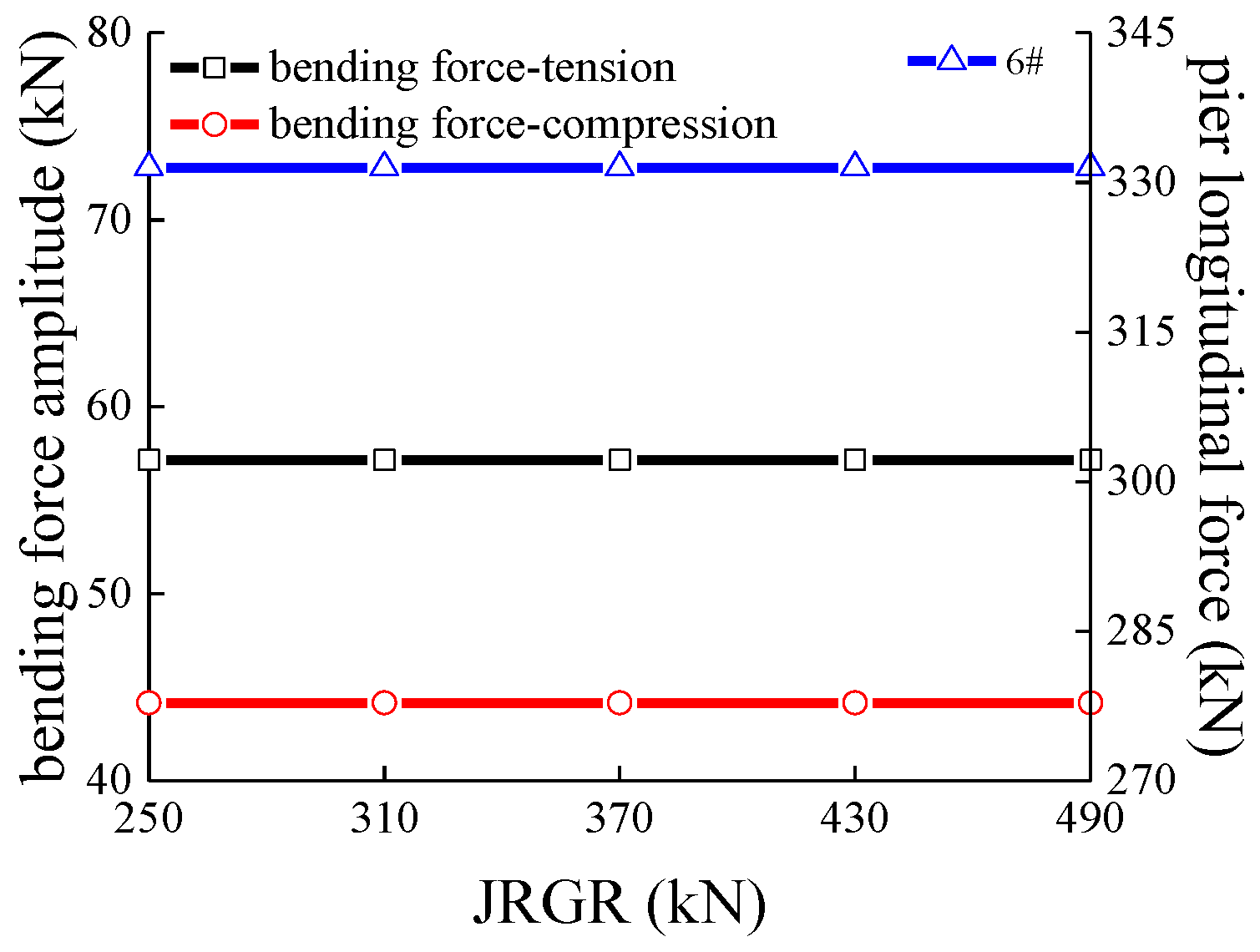

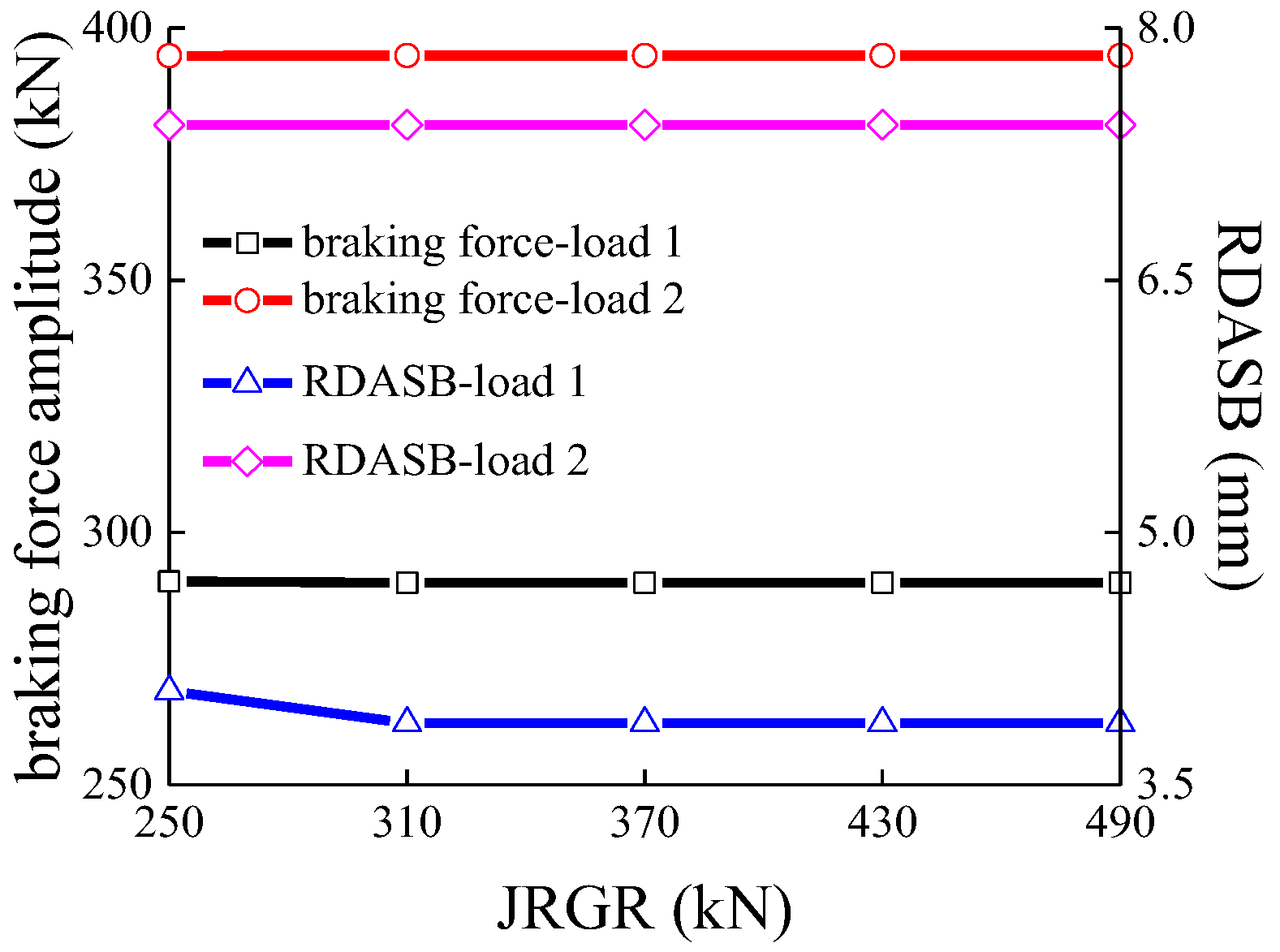
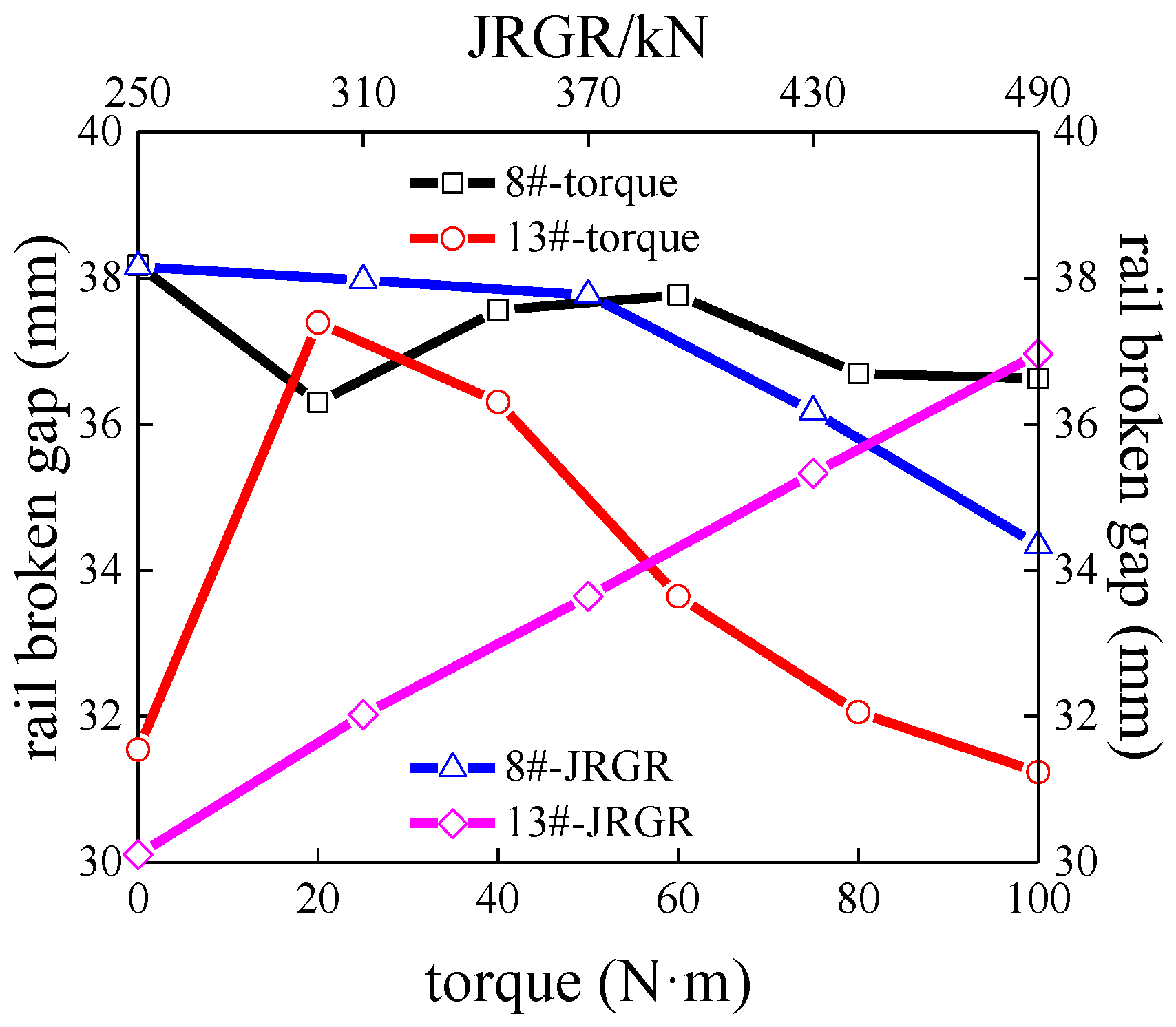
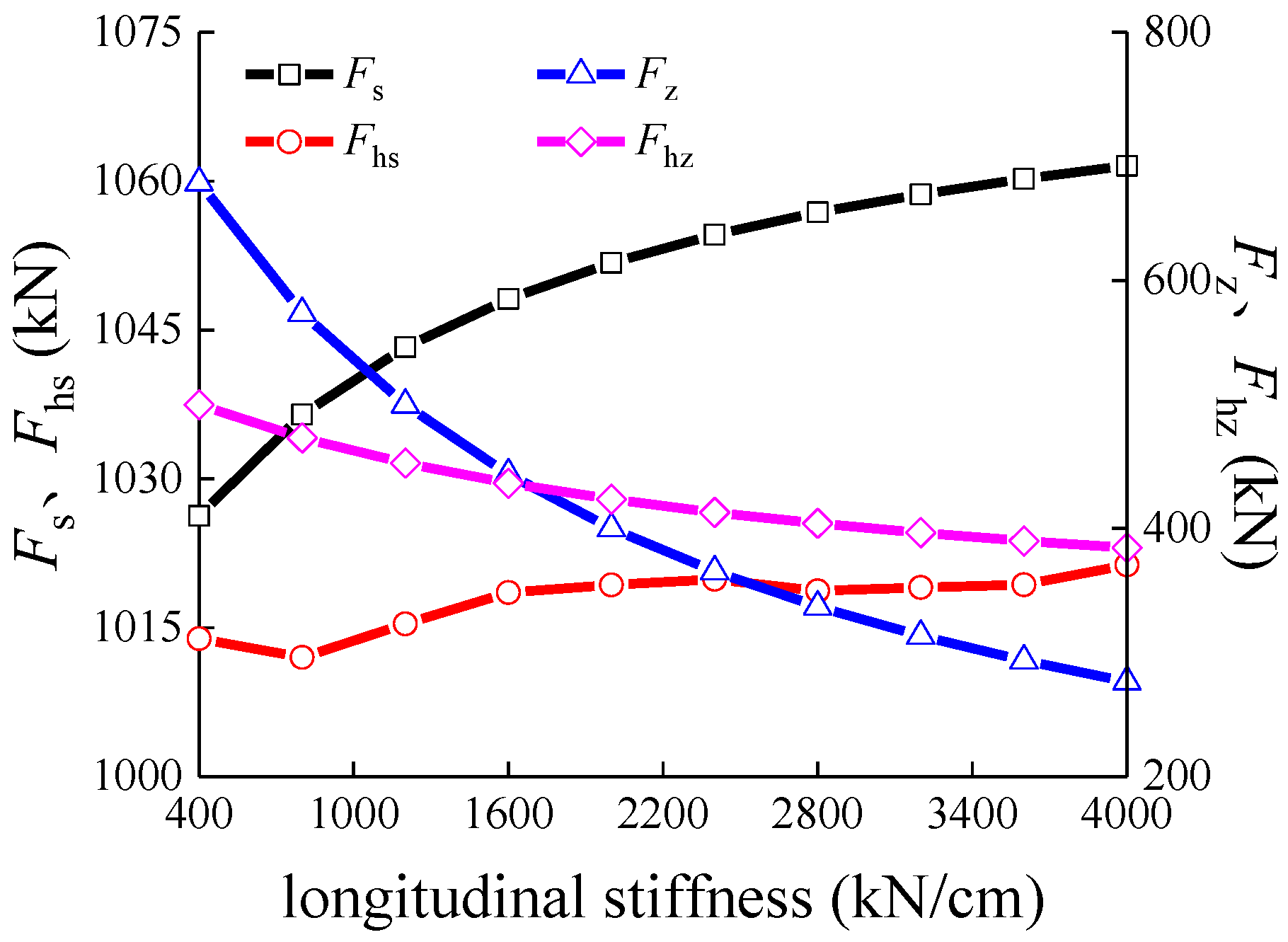
| Torque (N·m) | A | b | c | R2 | F0 (kN) | D3 (mm) |
|---|---|---|---|---|---|---|
| 20 | 3.67 | 10.06 | 0.52 | 0.8651 | 2.69 | 0.07 |
| 40 | 5.26 | 8.18 | 0.49 | 0.9530 | 3.91 | 0.15 |
| 60 | 8.29 | 6.32 | 0.51 | 0.9388 | 6.46 | 0.29 |
| 80 | 9.97 | 9.14 | 0.40 | 0.9718 | 8.39 | 0.48 |
| 100 | 14.03 | 2.88 | 0.55 | 0.9726 | 9.97 | 0.66 |
| Torque (N·m) | Stock Rail Longitudinal Force Amplitude (kN) | Pier Longitudinal Force Amplitude (kN) | Stock Rail Displacement Amplitude (mm) | |||
|---|---|---|---|---|---|---|
| Ref. [22] | Present Study | Ref. [22] | Present Study | Ref. [22] | Present Study | |
| Expansion | 209.2 | 206.2 | 126.4 | 122.8 | 6.4 | 6.3 |
| Bending | 30.2 | 35.4 | 7.0 | 7.0 | 0.25 | 0.28 |
| Braking | 358.0 | 363.6 | 264.2 | 269.9 | 11.2 | 11.5 |
| Spans of CGB (N·m) | Lower Limit of Piers Based on Equation (2) (kN/cm) | Upper Limit of Piers Based on Equation (3) (kN/cm) | Recommended Maximum Value (kN/cm) | ||||
|---|---|---|---|---|---|---|---|
| Rail Temperature Variation | Rail Temperature Variation | ||||||
| 30 °C | 40 °C | 50 °C | 30 °C | 40 °C | 50 °C | ||
| 32 + 48 + 32 | - | - | - | 163.9 | 129.9 | 101.6 | - |
| 40 + 64 + 40 | - | - | - | 652.0 | 617.3 | 612.2 | - |
| 44 + 80 + 44 | 1177.9 | 1338.9 | 1605.8 | 1279.1 | 1245.1 | 1281.6 | - |
| 50 + 92 + 50 | 400.0 | 400.0 | 400.0 | 2214.2 | 2147.3 | 2122.7 | 2120 |
| 60 + 100 + 60 | 400.0 | 400.0 | 400.0 | 3207.2 | 3033.3 | 2968.0 | 2960 |
Disclaimer/Publisher’s Note: The statements, opinions and data contained in all publications are solely those of the individual author(s) and contributor(s) and not of MDPI and/or the editor(s). MDPI and/or the editor(s) disclaim responsibility for any injury to people or property resulting from any ideas, methods, instructions or products referred to in the content. |
© 2023 by the authors. Licensee MDPI, Basel, Switzerland. This article is an open access article distributed under the terms and conditions of the Creative Commons Attribution (CC BY) license (https://creativecommons.org/licenses/by/4.0/).
Share and Cite
Xie, K.; Dai, W.; Xu, H.; Zhao, W. Influence of Guardrails on Track–Bridge Interaction with a Longitudinal Resistance Test of the Fastener. Appl. Sci. 2023, 13, 3750. https://doi.org/10.3390/app13063750
Xie K, Dai W, Xu H, Zhao W. Influence of Guardrails on Track–Bridge Interaction with a Longitudinal Resistance Test of the Fastener. Applied Sciences. 2023; 13(6):3750. https://doi.org/10.3390/app13063750
Chicago/Turabian StyleXie, Kaize, Weiwu Dai, Hao Xu, and Weigang Zhao. 2023. "Influence of Guardrails on Track–Bridge Interaction with a Longitudinal Resistance Test of the Fastener" Applied Sciences 13, no. 6: 3750. https://doi.org/10.3390/app13063750





